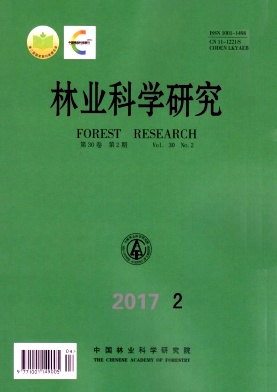-
森林生态系统在调节全球碳平衡以及减缓气候变化等方面起着重要作用[1]。毁林等土地利用变化已成为人类活动的第二大温室气体排放源,并可能影响全球气候的变化[2],通过森林恢复途径可以提高森林生态系统碳储量。近年来,我国的宜林地正在逐渐减少,但仍拥有大面积因人为管理不当或火灾、虫害等自然灾害造成的退化林地,这些退化林地的恢复将会提高中国森林生态系统碳储量。联合国粮农组织(FAO)认为,若在全球热带地区退化土地上开展人工促进天然更新,可以增加11.5~28.7Gt(Gt=109t)的固碳量[3]。《京都议定书》第3.4条款明确规定,附件Ⅰ缔约方国家可以选择计量包括植被恢复在内的一些人为活动引起的温室气体源排放或汇清除,用于抵消承诺的温室气体减排指标[4]。此外,在自愿碳市场,植被恢复也是农业、林业和其他土地利用(AFOLU)与气候、社区、生物多样性标准(CCBS)等自愿碳标准下的合格林业项目,占据非常重要的地位。因此,研究植被恢复对森林碳储量和碳汇的影响具有重大意义。
对森林恢复的研究可以追溯到20世纪30年代,美国最早发现生态系统退化问题并进行恢复研究,此后,德国、英国、日本和马来西亚等陆续针对大气污染下的退化森林恢复、寒温带针叶林采伐后植被恢复、东南亚森林采伐后恢复、受损和退化天然林生态恢复等进行了一系列研究[5]。中国自20世纪50年代以来,也陆续开展川西亚高山退化针叶林[6]、长江上游退化天然林[7]、喀斯特退化森林[8]、黄土丘陵区[9-10]和干热河谷区[11]等退化植被的恢复和重建研究。张远东等[12]研究发现,不同森林类型恢复过程中,次生针阔混交林地上生物量和林分蓄积量一直高于次生桦木林和人工云杉林;高成杰等[13]研究发现,与纯林恢复模式相比,采用混交林恢复能获得更多的生物量;康冰等[14]、李东胜等[15]也对植被恢复过程中土壤有机质和养分变化进行了研究,并取得一定成果;但当前的研究主要集中于森林恢复过程中,植被种类结构和生产力的变化特征及其对周围环境和土壤的影响等方面,关于植被恢复对森林生态系统碳储量影响的研究相对仍较少。
本文以湖南会同森林生态实验站(简称会同实验站,下同)杉木(Cunninghamia lanceolata (Lamb.) Hook.)人工林采伐后经自然恢复和人工恢复20年的森林生态系统为研究对象,通过分析2种不同恢复模式乔木层、灌木层、草本层、凋落物层和土壤层碳储量及其空间分布的差异,探讨植被恢复模式对森林生态系统碳库的影响,为进一步研究植被恢复对森林碳汇能力的影响提供科学依据。
HTML
-
会同实验站隶属中国科学院沈阳应用生态研究所,位于湖南省西南部的会同县广坪镇(26°48′E、109°30′N),属典型的亚热带湿润气候,年均气温16.5℃,年均降水量1 200~1 400 mm, 全年生长期在300 d以上。该区土壤为山地红黄壤,地带性植被类型为典型的亚热带常绿阔叶林,自然植被主要是以多种栲(Castanopsis)和石栎(Lithocarpus)属为主,而近年来由于人类活动的影响,形成了杉木人工林和以马尾松(Pinus massoniana Lamb.)为主的针阔混交林,或以白栎(Quercus fabri Hance)、枫香(Liquedabar formosana Hance)为主的次生落叶阔叶混交林。
本研究在杉木人工林皆伐后自然更新恢复林地(简称自然恢复样地,下同)和杉木人工林皆伐后通过人工栽植杉木纯林林地(简称人工恢复样地,下同)内进行,2个样地的地理位置相距较近,立地条件相似且皆伐前为密度相同的20年生1代杉木人工林,各样地基本特征见表 1。
样地类型
Stand type林龄
Stand age/a平均海拔
Mean altitude/m平均树高
Mean tree height/m平均胸径
Mean DBH/cm林分特征
Stand characteristics自然恢复样地
The experimental plot of natural restoration20 425 11.5 11.3 1995年将杉木人工林乔木皆伐后,无人为干扰,自然恢复的林地。恢复20年时,林分密度较大,生长杂乱。乔木层树种较多,无明显优势木,除极少量的杉木萌芽条外,还有青冈(Cyclobalanopsis glauca (Thunb.) Oerst.)、刨花楠(Machilus pauhoi Kanehira)、笔罗子(Meliosma rigida Sieb. et Zucc.)等多种乔木;灌木层和草本层植物也较丰富,主要有柃木(Eurya japonica Thunb.)、杜茎山(Maesa japonica (Thunb.) Moritzi.)、鼠刺(Itea chinensis Hook. et Arn.)等木本植物和狗脊(Woodwardia japonica (L. f.) Sm.)、山姜(Alpinia japonica (Thunb.) Miq.)、碎米莎草(Cyperus iria L.)等草本植物。 人工恢复样地
The experimental plot of artificial restoration20 521 19.3 22.9 1989年将杉木人工林乔木皆伐后,保留灌木和草本,第2年以2 400株·hm-2营造杉木人工林,由于初植密度较大,之后进行了2次抚育间伐,恢复20年时,乔木层为杉木,灌木层种类较少,以杜茎山、菝葜(Smilax china L.)为主;草本层主要有荩草(Arthraxon hispidus (Thunb.) Makino)、淡竹叶(Lophatherum gracile Brongn.)和狗脊等。 Table 1. General situation of experimental plots
-
2015年10月在自然恢复样地中按照坡位由上到下设置5个20 m×20 m调查样方,对样方中的乔木进行每木检尺,记录树种、胸径和树高;同时在每个样方中再设置1个10 m×10 m的样方,对其中所有的灌木和草本进行调查,记录种名、基径和株高;在样地中选取一些主要灌木、草本植株,测量其基径和株高后挖取全株带回实验室, 在75℃下烘干至恒质量,称量并记录每株的总干质量以及灌木各器官干质量,草本植物记录地上、地下部分干质量。
-
在每个样方中按品字形设置5个1×1 m小样方,收集小样方内全部凋落物,按照枯枝、枯叶、落果进行分类称质量,将凋落物各组分取样,带回实验室在75℃的恒温箱中烘干至恒质量。
-
土壤取样采用土钻法,在每个20 m×20 m样方中按照S形5点取样法,分0~10,10~20,20~40,40~60 cm 4层取样,将同一样方内相同土层所取的5份样品等量混合带回实验室,土壤样品风干后过2 mm筛备用,同时在每个样地挖2个土壤剖面,环刀法测定土壤密度。
-
2009年10月在人工恢复样地中按照坡位由上到下设置10个8 m×10 m调查样方,对样方中的乔木进行每木检尺,记录树种、胸径和树高,对样方中所有的灌木和草本进行调查,记录种名、基径和株高。凋落物层和土壤层调查方法同自然恢复样地调查方法一致。
-
结合乔木、灌木每木检尺和实验站数据库中各乔、灌树种异速生长方程计算乔木层、灌木层生物量,各树种异速生长方程详见会同实验站数据集[16]。利用采集的主要灌木植株基径、树高和实测生物量辅助选择最优异速生长方程。
实验站数据库中含有多年利用挖掘法测定的多种草本单株地上、地下生物量,由于相同基径、株高的同种草本具有相似生物量,利用计算机在数据库中查找与调查时记录的草本同种且基径株高一致的植株,将这些条件相同的草本生物量平均值作为所测草本植株的生物量。
利用调查时获得的干/鲜质量比计算含水率,进而根据鲜质量和含水率推算凋落物的生物量现存量。
-
采用重铬酸钾—浓硫酸氧化外加热法测定采集的杜茎山、鼠刺等13种主要灌木草本各器官碳含量及自然恢复样地凋落物和土壤的碳含量,乔木、未采集的灌木草本及人工恢复样地凋落物和土壤的碳含量引自生态站长期监测数据库中的数据。
-
根据乔木层、灌木层、草本层、凋落物层不同部位生物量和测定的相应碳含量,计算林分各层的碳储量,土壤层碳储量计算公式[17]:
式中: S为土壤层有机碳储量(t·hm-2),Ci为第i层土壤有机碳含量(%),di为第i层平均土壤密度(g·cm-3);Hi表示第i层土壤的厚度(m);n为土壤层数。
-
采用Excel软件对数据进行处理,用SPSS19.0软件进行单因素方差分析,应用最小显著差异法(LSD)分析不同数据组间的差异性,显著性水平设置为α=0.05。
2.1. 样地设置及植被调查
2.1.1. 自然恢复样地
2.1.1.1. 乔木层和林下植被层调查
2.1.1.2. 凋落物层调查
2.1.1.3. 土壤层调查
2.1.2. 人工恢复样地
2.2. 碳储量计算方法
2.2.1. 生物量计算方法
2.2.2. 碳含量测定方法
2.2.3. 碳储量计算方法
2.3. 数据处理
-
由表 2看出:自然恢复模式的乔木层碳储量为99.21 t·hm-2,比人工恢复模式显著高22.56%。乔木层各器官碳储量中,除自然恢复模式的树干碳储量略比人工恢复模式小外,其它器官均比人工恢复模式的大,且枝、叶、根碳储量均显著比人工恢复模式的高。此外,恢复模式对乔木层各器官碳储量分配比有一定影响,人工恢复模式为干﹥根﹥枝﹥皮﹥叶;而自然恢复模式为干﹥枝﹥根﹥叶﹥皮。虽然2种模式中均以树干碳储量的分配最大,但人工恢复模式中树干碳储量达到乔木层总碳储量的62.30%,而自然恢复模式中只有47.87%,二者差异显著。
指标
Index恢复模式
Restoration approaches干
Stem枝
Branch皮
Bark叶
Leaf根
Root总计
Total碳储量
Carbon storage/(t·hm-2)人工恢复
Artificial restoration50.43±3.95Aa 7.24±0.58Bc 6.86±0.53Ac 3.67±0.29Bd 12.75±1.00Bb 80.95±6.20B 自然恢复
Natural restoration47.49±10.92Aa 18.03±4.96Ab 7.30±0.94Ac 9.63±1.29Ac 16.76±4.90Ab 99.21±20.74A 分配比
Distribution ratio/%人工恢复
Artificial restoration62.30±0.36A 8.94±0.11B 8.47±0.34A 4.54±0.24B 15.75±0.10A 100 自然恢复
Natural restoration47.87±2.24B 18.17±1.61A 7.36±0.23B 9.71±2.60A 16.89±1.89A 100 注:表中数据是平均值±标准差,不同大写字母表示不同恢复模式碳储量差异显著(P<0.05),不同小写字母表示乔木层植被不同器官碳储量差异显著(P<0.05)。
Note: Mean ± standard deviation is given in the table data, different capital letters indicate the different restoration approach carbon stocks significantly different(P<0.05), different lowercase letters indicate differences in carbon storage in different organs of the tree layer significantly (P<0.05).Table 2. The carbon storage and distribution of tree layer under two restoration approaches
-
由表 3可知:自然恢复模式的灌木层总碳储量显著比人工恢复模式的高。恢复20 a时,自然恢复模式灌木层碳储量约为人工恢复模式的3.99倍,干、枝、叶、根碳储量分别为人工恢复模式相应器官碳储量的3.77、3.16、3.29、5.94倍。恢复模式对灌木层各器官碳储量分配比有一定影响,主要表现在根器官,人工恢复模式各器官碳储量分配比为:干﹥枝﹥根﹥叶,自然恢复模式分配比为:干﹥根﹥枝﹥叶。人工恢复模式根仅占灌木层总碳储量的20.88%,而自然恢复模式根所占比例为31.15%,二者差异显著。可见,自然恢复模式更有利于灌木层碳的积累。
指标
Index恢复模式
Restoration approaches干
Stem枝
Branch叶
Leaf根
Root总计
Total碳储量
Carbon storage/(t·hm-2)人工恢复
Artificial restoration0.090±0.008Ba 0.058±0.005Bb 0.049±0.005Bc 0.052±0.006Bbc 0.249±0.022B 自然恢复
Natural restoration0.339±0.051Aa 0.183±0.028Ab 0.161±0.023Ab 0.309±0.031Aa 0.992±0.102A 分配比Distribution ratio/% 人工恢复
Artificial restoration36.15±0.38A 23.29±0.24A 19.68±1.08A 20.88±1.49B 100 自然恢复
Natural restoration34.17±3.04A 18.45±1.35B 16.23±1.74B 31.15±2.75A 100 注:表中数据是平均值±标准差,不同大写字母表示不同恢复模式碳储量差异显著(P<0.05),不同小写字母表示灌木层植被不同器官碳储量差异显著(P<0.05)。
Note: Mean ± standard deviation is given in the table data, different capital letters indicate the different restoration approach carbon stocks significantly different(P<0.05), different lowercase letters indicate differences in carbon storage in different organs of the shrub layer significantly(P<0.05).Table 3. The carbon storage and distribution of shrub layer under two restoration approaches
-
由表 4可知:自然恢复模式草本层碳储量显著比人工恢复模式的高。自然恢复模式草本层地上部分、地下部分和总碳储量分别为人工恢复模式的5.08、9.00、5.94倍,自然恢复模式地上部分与地下部分碳储量之比为1.36,而人工恢复模式为2.40,说明自然恢复模式更有利于草本层碳储量的积累,而且更能促进地下部分碳储量的积累。
指标
Index恢复模式
Restoration approaches地上部分
Aboveground地下部分
Underground总计
Total碳储量Carbon storage/(t·hm-2) 人工恢复Artificial restoration 0.012±0.006Ba 0.005±0.001Ba 0.018±0.006B 自然恢复Natural restoration 0.061±0.015Aa 0.045±0.023Aa 0.107±0.035A 分配比Distribution ratio/% 人工恢复Artificial restoration 70.59±10.10A 29.41±10.10A 100 自然恢复Natural restoration 57.55±7.73A 42.45±7.73A 100 注:表中数据是平均值±标准差,不同大写字母表示不同恢复模式碳储量差异显著(P<0.05),不同小写字母表示草本层植被不同器官碳储量差异显著(P<0.05)。
Note: Mean ± standard deviation is given in the table data, different capital letters indicate the different restoration approach carbon stocks significantly different (P<0.05), different lowercase letters indicate differences in carbon storage in different organs of the herb layer significantly(P<0.05).Table 4. The carbon storage and distribution of herb layer under two restoration approaches
-
由表 5可以得到:自然恢复模式凋落物层碳储量略高于人工恢复模式,但恢复模式对凋落物各器官分配比有一定的影响,两种恢复模式中枯枝碳储量所占比例的差异不显著,自然模式枯叶碳储量所占比例大于人工恢复模式,但是落果碳储量所占比例仅为2.78%,显著比人工恢复模式的小。
指标
Index恢复模式
Restoration approaches枯枝
Deadwood枯叶
Dead leaves落果
Fallen fruit总计
Total碳储量Carbon storage/(t·hm-2) 人工恢复Artificial restoration 1.13±0.15Ab 1.49±0.17Ba 0.23±0.07Ac 2.85±0.12A 自然恢复Natural restoration 1.29±0.24Ab 1.86±0.35Aa 0.09±0.02Bc 3.24±0.60A 分配比Distribution ratio/% 人工恢复Artificial restoration 39.65±4.60A 52.28±5.64A 8.07±2.62A 100 自然恢复Natural restoration 39.81±3.25A 57.41±4.77A 2.78±0.92B 100 注:表中数据是平均值±标准差,不同大写字母表示不同恢复模式碳储量差异显著(P<0.05),不同小写字母表示不同器官凋落物碳储量差异显著(P<0.05)。
Note: Mean ± standard deviation is given in the table data, different capital letters indicate the different restoration approach carbon stocks significantly different(P<0.05), different lowercase letters indicate differences in carbon storage in different organs of the litter layer significantly(P<0.05).Table 5. The carbon storage and distribution of litter layer under two restoration approaches
-
由表 6可知:自然恢复模式土壤层总碳储量显著小于人工恢复模式。从2种恢复模式各层土壤碳储量来看,自然恢复模式表层(0~10 cm)土壤碳储量略高于人工恢复模式,其它各层则相反,2种恢复模式土壤碳储量在10~20 cm土层差异显著,在其它各层差异不显著。2种恢复模式土壤碳储量在各层的分配比也有一定差异,自然恢复模式从上到下各层碳储量分别占总碳储量的41.44%、17.18%、25.26%和16.07%;而人工恢复模式从上到下分别占30.25%、20.25%、29.22%和20.28%,垂直方向上2种恢复模式土壤碳储量均随土层深度的增加而减少。
指标Index 恢复模式
Restoration approaches土壤层Soil layer/cm 总计
Total0~10 10~20 20~40 40~60 碳储量
Carbon storage/(t·hm-2)人工恢复
Artificial restoration24.91±6.13A 16.68±3.05A 24.06±6.04A 16.70±3.29A 82.36±7.49A 自然恢复
Natural restoration30.44±5.84A 12.60±1.24B 18.53±1.64A 11.79±2.11A 73.36±5.69B 碳储量分配比
The distribution ratio of carbon storage/%人工恢复
Artificial restoration30.25±6.89B 20.25±3.65A 29.22±5.19A 20.28±5.28A 100 自然恢复
Natural restoration41.49±4.84A 17.18±1.48A 25.26±2.43A 16.07±3.36A 100 按10 cm分层的碳储量
Carbon storage per 10 cm/(t·hm-2)人工恢复
Artificial restoration24.91±6.13Aa 16.68±3.05Ab 12.03±3.02Ac 8.35±3.69Ac 自然恢复
Natural restoration30.44±5.84Aa 12.60±1.24Bb 9.26±0.82Abc 5.90±1.06Ac 碳含量
Carbon content/(g·kg-3)人工恢复
Artificial restoration20.76±5.12Aa 13.90±2.55Ab 10.02±2.52Ac 6.85±1.49Ac 自然恢复
Natural restoration22.86±4.07Aa 8.83±0.67Bb 6.41±0.62Bbc 4.16±0.86Ac 注:表中数据是平均值±标准差,不同大写字母表示不同恢复模式碳储量差异显著(P<0.05),不同小写字母表示不同土壤层碳储量差异显著(P<0.05)。
Note: Mean ± standard deviation is given in the table data, different capital letters indicate the different restoration approach carbon stocks significantly different(P<0.05), different lowercase letters indicate differences in levels of carbon storage in soil layers significantly(P<0.05).Table 6. The carbon storage and distribution of soil layer under two restoration approaches
从2种恢复模式各层土壤的碳含量来看,表层(0~10 cm)表现为自然恢复模式略大于人工恢复模式,其它各层则相反。垂直方向上2种恢复模式土壤碳含量均随土层深度的增加而减少,人工恢复模式除20~40、40~60 cm土层间差异不显著外,其它各土层间均差异显著,表层碳含量分别为其它3层的1.49、2.07和3.03倍。自然恢复模式表层土壤碳含量与其它3层差异显著,其碳含量分别为另外3层的2.59、3.57和5.50倍。
-
由表 7可知:自然恢复模式生态系统总碳储量略高于人工恢复模式。生态系统中除土壤层碳储量为自然恢复模式小于人工恢复模式外,其它组分碳储量均为自然恢复模式大于人工恢复模式,且乔木层、灌木层、草本层在2种恢复模式下差异显著,其中,自然恢复模式乔木层碳储量比人工恢复模式高18.26 t·hm-2,约占人工恢复模式林地生态系统总碳储量的22.56%。
指标
Index恢复模式
Restoration approaches乔木层
Tree layer灌木层
Shrub layer草本层
Herb layer凋落物层
Litter layer土壤层
Soil layer总计
Total碳储量
Carbon storage/(t·hm-2)人工恢复
Artificial restoration80.95±6.20B 0.249±0.022B 0.018±0.006B 2.85±0.12A 82.36±7.49A 166.43±10.11A 自然恢复
Natural restoration99.21±20.74A 0.993±0.102A 0.107±0.035A 3.24±0.60A 73.36±5.69B 176.91±23.52A 分配比Distribution ratio/% 人工恢复
Artificial restoration48.64 0.15 0.01 1.71 49.49 100 自然恢复
Natural restoration56.08 0.56 0.06 1.83 41.47 100 注:表中数据是平均值±标准差,不同大写字母表示不同恢复模式碳储量差异显著(P<0.05)。
Note: Mean ± standard deviation is given in the table data, different capital letters indicate the different restoration approach carbon stocks significantly different(P<0.05).Table 7. The carbon storage and distribution of ecosystem under two restoration approaches
2种恢复模式碳储量在生态系统各组分中的分配有一定差异,自然恢复模式生态系统乔木层碳储量最大,占总储量的56.08%,其次是土壤层,占41.47%,凋落物层、灌木层和草本层碳储量较小;而人工恢复模式土壤层碳储量最大,占总储量的49.49%,其次是乔木层,占48.64%,凋落物层、灌木层和草本层碳储量也较小,这表明恢复模式对碳储量在生态系统各组分的分配产生一定影响。
3.1. 自然恢复与人工恢复乔木层碳储量的比较
3.2. 自然恢复与人工恢复灌木层碳储量的比较
3.3. 自然恢复与人工恢复草本层碳储量的比较
3.4. 自然恢复与人工恢复凋落物层碳储量比较
3.5. 自然恢复与人工恢复土壤层碳储量比较
3.6. 自然恢复与人工恢复生态系统总碳储量比较
-
本研究发现,自然恢复模式植被层碳储量大于人工恢复模式,与邸月宝等[18]得出的自然更新林地固碳能力显著高于人工更新林地的结论一致。
2种恢复模式林地乔木层碳储量差异显著,这可能是因为自然恢复模式形成了次生针阔混交林,人工恢复模式形成了杉木纯林。许多研究发现,混交林中树种较多,占据不同生态位的树种可以互补;同时混交林具有更好的抗干扰性,可以积累较多的植被生物量和碳汇[19-21]。此外,恢复模式对乔木层各器官碳储量分配比有一定影响,这可能有两方面的原因:其一,2种恢复模式形成的林分树种具有差异,不同树种各器官碳储量分配比有所不同[22];其二:自然恢复模式形成的次生针阔混交林中有许多后期萌发的幼龄树,不同林龄的树木各器官生物量、碳储量分配比也有所不同[23]。
2种恢复模式林下植被层碳储量的差异显著,这可能是因为自然恢复模式形成的次生针阔混交林林内树种较多,灌木、草本种子和萌芽较多,其生物量和碳储量相对较大。此外,人工恢复模式营造杉木纯林郁闭较早,罗达等[24]研究发现, 随乔木生长, 乔木和林下灌草之间资源竞争加剧, 导致林下灌草生长受限,也会在一定程度上影响生物量和碳储量。
-
本研究发现,自然恢复模式土壤平均碳含量和碳储量均小于人工恢复模式,这与徐桂林等[25]的研究结论一致。这是因为不同恢复模式对植被、林地环境、土壤性质和微生物活动等的影响不同,导致土壤碳含量和碳储量不同[26]。2种恢复模式土壤层碳储量均小于方晰等[26]测定的22年生杉木纯林采伐前林地土壤0~60 cm的碳储量(160.38 t·hm-2),说明采伐使林地土壤碳储量有较大程度减少,且短期之内很难恢复到伐前水平。
自然恢复模式土壤总碳储量小于人工恢复模式,但表层土壤碳储量却相反。这可能是自然恢复模式形成的次生针阔混交林植被生物量较大,凋落物也较多,表层土壤的有机碳输入量较大, 同时自然恢复模式中幼龄树较多,土壤深层中的根系生物量和分泌物相对较少,土壤有机碳输入较少[24]。
-
杉木人工林伐后林地在不同恢复模式恢复20 a时生态系统各组分的分配比产生了明显差异,说明恢复模式除对生态系统总碳储量产生一定影响外,对碳储量在生态系统各组分的分配也产生了一些影响。
本研究得到自然恢复模式恢复林地总碳储量大于人工恢复模式,说明杉木人工林伐后林地自然恢复模式固碳能力高于人工恢复模式,但在实际林地恢复中除考虑林分碳储量问题,还要考虑蓄积量、出材量等问题。此外,本研究中人工恢复模式仅考虑杉木纯林一种模式,许多研究表明,造林密度、树种、结构等都会影响林地碳储量[20],因此, 不同恢复模式对杉木人工林伐后恢复林地碳储量的影响还有待进一步研究。
4.1. 杉木人工林伐后不同恢复模式对植被层碳储量的影响
4.2. 杉木人工林伐后不同恢复模式对土壤层碳储量的影响
4.3. 杉木人工林伐后不同恢复模式对森林生态系统总碳储量的影响
-
(1) 自然恢复模式植被层碳储量明显大于人工恢复模式,其中,乔木层碳储量为自然恢复模式高出人工恢复模式22.56%。2种恢复模式乔木层各器官的碳储量分配格局也有所不同,人工恢复模式为干﹥根﹥枝﹥皮﹥叶;而自然恢复模式为干﹥枝﹥根﹥叶﹥皮。林下植被层和凋落物层碳储量所占比例非常小,自然恢复模式灌木层、草本层和凋落物层碳储量分别为人工恢复模式的3.99、5.94、1.14倍。
(2) 土壤层总碳储量表现为自然恢复模式小于人工恢复模式,表层(0~10 cm)土壤碳含量和碳储量为自然恢复模式大于人工恢复模式,其它土层则相反;2种恢复模式土壤碳含量、碳储量均随土层深度的增加而减少,不同恢复模式土壤各层碳储量所占分配比差异明显。
(3) 自然恢复模式生态系统总碳储量略高于人工恢复模式,2种模式下杉木人工林生态系统碳储量在各组分的分配情况具有明显差异,自然恢复模式各组分碳储量为乔木层﹥土壤层﹥凋落物层﹥灌木层﹥草本层,而人工恢复模式为土壤层﹥乔木层﹥凋落物层﹥灌木层﹥草本层。杉木人工林皆伐后林地自然恢复模式固碳能力高于人工恢复模式。





 DownLoad:
DownLoad: